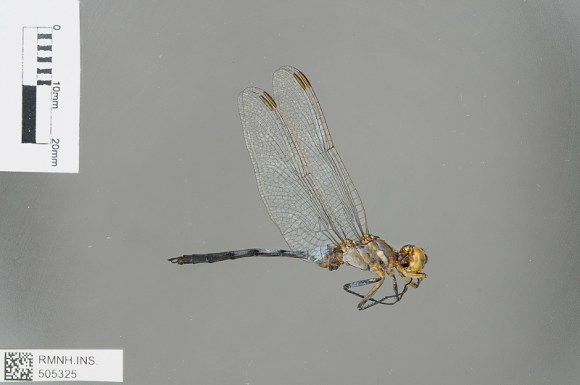Orthetrum chrysostigma (Burmeister, 1839)
Epaulet Skimmer
Type locality: Tenerife, Canary Islands, Spain
Diagnosis
Male is similar to O. brevistylum by (a) thorax with 1-3 contrasting whitish stripes on each side, each one with dark border on anterior or both sides; (b) when stripes are faint or invisible due to pruinosity, then labium and labrum all pale, lobe of hamule low and Abd always shorter than Hw; (c) metepimeral carina often largely marked with black line. Dorsal carina of Abd (narrowly) black; (d) hamule without ridge and/or hook is placed at its end, profile of hamule thus has 2 points (1 if lobe is low), hook being anterior one; (e) hook of hamule turned outward. However, differs by (1) being widespread; (2) larger size, Hw 27-35 mm; (3) membranule dark rather than whitish; (4) Pt 3-4 mm; (5) only mesepimeron with whitish stripe; metepimeral carina largely marked with black line; (6) lobe of hamule separated from hook. [Adapted from Dijkstra & Clausnitzer 2014; this diagnosis not yet verified by author]
Habitat description
Mostly streams, but possibly also seeps, springs, headwaters, rivers and often temporary standing waters, in open (often rather dry) landscapes, but sometimes in open areas in forest. Probably especially calmer sections (like pools) with a soft (like muddy) bottom. From 0 to 2300 m above sea level, but possibly higher up.
Distribution

Male & female (matur © Robert Ketelaar

Male (young) © Allan Brandon
 Abdominal segment 2 (lateral view) |
Map citation: Clausnitzer, V., K.-D.B. Dijkstra, R. Koch, J.-P. Boudot, W.R.T. Darwall, J. Kipping, B. Samraoui, M.J. Samways, J.P. Simaika & F. Suhling, 2012. Focus on African Freshwaters: hotspots of dragonfly diversity and conservation concern. Frontiers in Ecology and the Environment 10: 129-134.
Barcode specimen(s):

Adult, male; Zimbabwe, Manicaland, © Dijkstra, K.-D.B.

Adult, male; Angola, Cuanza Norte Province, Ndalatando © Dijkstra, K.-D.B.

Female; Democratic Republic of Congo, Katanga, © Dijkstra, K.-D.B.

Male; Democratic Republic of Congo, Katanga, © Dijkstra, K.-D.B.

Female; Democratic Republic of Congo, Katanga, © Dijkstra, K.-D.B.

Male; Democratic Republic of Congo, Katanga, © Dijkstra, K.-D.B.

Male; Tanzania, Kigoma Region, Lower Malagarasi Basin © Dijkstra, K.-D.B.
References
- Burmeister, H. (1839). Handbuch der Entomologie. Zweiter Band, Befondere Entomologie. Zweite Abtheilung. Kauterfe. Gymnognatha. (Zweite hälfte; vulgo Neuroptera). Enslin, Berlin 755-1050. Odonata, 805-862.
- Ris, F. (1921). The Odonata or Dragonflies of South Africa. Annals South African Museum, XVIII, 245-452. [PDF file]
- Longfield, C. (1936). Studies on African Odonata, with synonymy and descriptions of new species and subspecies. Transactions Royal Entomological Society London, 85, 467-498. [PDF file]
- Longfield, C. (1931). A list of the Odonata of British Somaliland and a description of a new species of the genus Enallagma. Entomologist, 64, 274-278. [PDF file]
- Pinhey, E.C.G. (1961). Dragonflies (Odonata) of Central Africa. Occasional Papers Rhodes-Livingstone Museum, 14, 1-97. [PDF file]
- Pinhey, E.C.G. (1966). Check-list of dragonflies (Odonata) from Malawi, with description of a new Teinobasis Kirby. Arnoldia, 2, 1-24. [PDF file]
- Sjöstedt, Y. (1900). Odonaten aus Kamerun, West -Afrika. Beltrage Zur Kenntnis der insektenfauna von Kamerun. Binhang Kongliga Svenka VetenskapsAkademiens Handlingar, 25, 1-62.
- Martin, R. (1907). Odonates de la Guinée espagnole. Memorias Sociedad espanola Historia natural, 1, 421-432. [PDF file]
- Schouteden, H. (1934). Annales Musee Congo belge Zoologie 3 Section 2, 3, 1-84. [PDF file]
- Lieftinck, M.A. (1969). Odonates Anisoptères - Odonata Anisoptera. Explor. hydrob. Lac Bangweolo and Luapula, 14, 1-64. [PDF file]
- Kirby, W.F. (1900). Report on the Neuroptera Odonata collected by Mr E. E. Austen at Sierra Leone during August and September 1899. Annals Magazine Natural History, 6, 67-79. [PDF file]
- Pinhey, E.C.G. (1971). Odonata collected in Republique Centre-Africaine by R. Pujol. Arnoldia, 5, 1-16. [PDF file]
- Schmidt, E. (1951). Libellen aus Portugiesisch Guinea, mit Bemerkungen über andere aethiopische Odonaten. Arquivos Museu Bocage, 20, 125-200. [PDF file]
- Longfield, C. (1955). The Odonata of N. Angola. Part I. Publicacoes culturais Companhia Diamantes Angola, 27, 11-63. [PDF file]
- D' Andrea, M., and Carfi, S. (1997). Nuove raccolte di odonati del Camerun con note su Agriocnemis maclachlani Selys, 1877 edescrizione di Agriocnemis dissimilis sp. nov. e Trithemis osvaldae sp. nov. Atti Societa italiana Scienze naturali, 136, 157-190. [PDF file]
Citation: Dijkstra, K.-D.B (editor). African Dragonflies and Damselflies Online. http://addo.adu.org.za/ [2024-07-27].

